Tarbes
Tarbes (French pronunciation: [taʁb]; Gascon: Tarba) is a commune in the Hautes-Pyrénées department in the Occitanie region of southwestern France. It is the capital of Bigorre. It has been a commune since 1790. It was known as Turba or Tarba in Roman times.[2] Tarbes is part of the historical region of Gascony.
Tarbes | |
|---|---|
Prefecture and commune | |
.jpg) The town hall of Tarbes | |
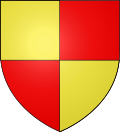 Coat of arms | |
Location of Tarbes 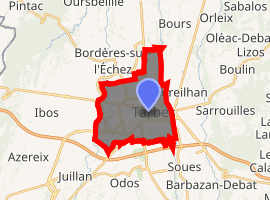
| |
 Tarbes  Tarbes | |
| Coordinates: 43°14′N 0°04′E | |
| Country | France |
| Region | Occitanie |
| Department | Hautes-Pyrénées |
| Arrondissement | Tarbes |
| Canton | 3 cantons |
| Intercommunality | CA Tarbes-Lourdes-Pyrénées |
| Government | |
| • Mayor (From 2001) | Gérard Trémège (PR) |
| Area 1 | 15.33 km2 (5.92 sq mi) |
| Population (2017-01-01)[1] | 41,518 |
| • Density | 2,700/km2 (7,000/sq mi) |
| Time zone | UTC+01:00 (CET) |
| • Summer (DST) | UTC+02:00 (CEST) |
| INSEE/Postal code | 65440 /65000 |
| Elevation | 284–326 m (932–1,070 ft) (avg. 304 m or 997 ft) |
| 1 French Land Register data, which excludes lakes, ponds, glaciers > 1 km2 (0.386 sq mi or 247 acres) and river estuaries. | |
Formerly of strong industrial tradition, Tarbes today tries to diversify its activities, particularly in aeronautics and high tech around the different zones of activities which are increasing. The recent development of Tarbais beans and other regional specialties also shows a willingness to develop the agri-food industry thus justifying its nickname of "market town". Its 42,888 inhabitants are called Tarbaises and the Tarbais.
It is the seat of the diocese of Tarbes-et-Lourdes. The 1st Parachute Hussar Regiment and 35th Parachute Artillery Regiment are stationed in Tarbes.
Geography
Location
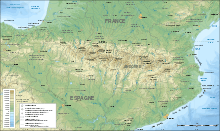
Tarbes is a Pre-Pyrenees town within the rich agricultural plain of the river Adour, 155 kilometres (96 miles) southwest of Toulouse, 144 kilometres (89 miles) to the east of Bayonne, 70 kilometres (43 miles) southwest of Auch and 20 kilometres (12 miles) northeast of Lourdes. Tarbes is 1 hr 30 mins from the Atlantic Ocean, 2 hrs 50 mins from the Languedoc coast and 35 minutes from the nearest ski resorts. It is located at an average elevation of 304 metres (997 feet).
To the south of Tarbes, along with the pilgrimage town of Lourdes, is the border with Spain. The Pyrenees mountains, lying along the border between France and Spain, can be seen from the town.
Hydrography
Tarbes is crossed to the east by the Adour river and to the west by the Échez and by the Gespe, a tributary which joins the Échez on the territory of the commune.
Neighbouring communes

Climate
Tarbes features an oceanic climate (Köppen climate classification: Cfb), with relatively hot summers, mild winters and abundant rainfall. Tarbes benefits from its privileged location in the area of the Adour, a milder microclimate than at Lourdes, from a higher altitude, and somewhat less rainy than in Pau, and sunnier. Summers are warm and often stormy, while spring is rainy and cool and autumn is mild and sunny. Winter, meanwhile, is less rigorous but can still hold some surprises. The lowest temperature was recorded in January 1985 with a temperature under shelter of −17.9 °C (−0.2 °F). Conversely, there was a maximum temperature of 39 °C (102 °F) in August 2003.
| Location | Sunshine | Rain | Snow | Storm | Fog |
|---|---|---|---|---|---|
| Paris | 1,630 hrs/yr | 642 millimetres (25.3 in)/yr | 15 days/yr | 19 days/yr | 13 days/yr |
| Nice | 2,694 hrs/yr | 767 millimetres (30.2 in)/yr | 1 day/yr | 31 days/yr | 1 day/yr |
| Toulouse | 2,010 hrs/yr | 656 millimetres (25.8 in)/yr | 7 days/yr | 26 days/yr | 44 days/yr |
| Pau | 1,850 hrs/yr | 1,069 millimetres (42.1 in)/yr | 6 days/yr | 27 days/yr | 42 days/yr |
| Tarbes | 1,940 hrs/yr | 975 millimetres (38.4 in)/yr | 9 days/yr | 29 days/yr | 31 days/yr |
| National average | 1,973 hrs/yr | 770 millimetres (30 in)/yr | 14 days/yr | 22 days/yr | 40 days/yr |
| Climate data for Tarbes, France (altitude 360m, 1981–2010) (Source: Météo-France, Infoclimat.fr) | |||||||||||||
|---|---|---|---|---|---|---|---|---|---|---|---|---|---|
| Month | Jan | Feb | Mar | Apr | May | Jun | Jul | Aug | Sep | Oct | Nov | Dec | Year |
| Record high °C (°F) | 22.6 (72.7) |
29.2 (84.6) |
29.1 (84.4) |
30.1 (86.2) |
32.9 (91.2) |
37.9 (100.2) |
38.2 (100.8) |
39.0 (102.2) |
35.8 (96.4) |
33.8 (92.8) |
27.6 (81.7) |
26.1 (79.0) |
39.0 (102.2) |
| Average high °C (°F) | 10.3 (50.5) |
11.3 (52.3) |
14.2 (57.6) |
15.8 (60.4) |
19.5 (67.1) |
22.8 (73.0) |
25.1 (77.2) |
25.2 (77.4) |
22.8 (73.0) |
19.0 (66.2) |
13.7 (56.7) |
11.0 (51.8) |
17.6 (63.7) |
| Average low °C (°F) | 1.0 (33.8) |
1.5 (34.7) |
3.7 (38.7) |
5.6 (42.1) |
9.5 (49.1) |
12.8 (55.0) |
14.9 (58.8) |
14.9 (58.8) |
11.9 (53.4) |
8.7 (47.7) |
4.3 (39.7) |
1.8 (35.2) |
7.6 (45.7) |
| Record low °C (°F) | −17.9 (−0.2) |
−14.4 (6.1) |
−9.8 (14.4) |
−3.4 (25.9) |
−1.8 (28.8) |
2.3 (36.1) |
5.9 (42.6) |
5.3 (41.5) |
0.7 (33.3) |
−3.3 (26.1) |
−9.6 (14.7) |
−13.4 (7.9) |
−17.9 (−0.2) |
| Average precipitation mm (inches) | 95.0 (3.74) |
81.1 (3.19) |
87.0 (3.43) |
111.7 (4.40) |
111.6 (4.39) |
78.0 (3.07) |
56.0 (2.20) |
68.1 (2.68) |
71.6 (2.82) |
88.1 (3.47) |
102.5 (4.04) |
96.7 (3.81) |
1,047.4 (41.24) |
| Average precipitation days (≥ 1.0 mm) | 10.6 | 9.4 | 10.2 | 12.5 | 13.1 | 9.5 | 7.1 | 8.5 | 8.6 | 10.6 | 10.0 | 10.3 | 120.3 |
| Average snowy days | 2.2 | 2.1 | 1.7 | 0.6 | 0.0 | 0.0 | 0.0 | 0.0 | 0.0 | 0.0 | 0.9 | 1.7 | 9.2 |
| Average relative humidity (%) | 81 | 78 | 76 | 77 | 78 | 78 | 77 | 79 | 78 | 81 | 82 | 82 | 78.9 |
| Mean monthly sunshine hours | 118.3 | 129.2 | 169.2 | 170.2 | 189.1 | 197.9 | 204.9 | 206.0 | 189.8 | 150.6 | 117.5 | 108.7 | 1,951.2 |
| Source 1: Météo France[3][4] | |||||||||||||
| Source 2: Infoclimat.fr (humidity and snowy days, 1961–1990)[5] | |||||||||||||
Toponymy
The town was named for the first time in the 5th century as Civitas Turba ubi castrum Bigòrra. It was an important city of the Novempopulania. Gregory of Tours in the 6th century named Talvam vicum.
In the Middle Ages it was called Tarbé (1214), Tursa, Tarvia (1284) and also Tarbia. Not to be confused with the Tarbelli, whose capital was Dax.
Legendary origin of the name
Legend holds that the Queen of Ethiopia, Tarbis, proposed her love to Moses and that he refused. Inconsolable, she decided to leave her throne and hide her disappointment. After many wanderings, she arrived in Bigorre and built her home on the Adour to found the town of Tarbes, and its sister, on the banks of the Gave de Pau, arose as Lourdes.
History
Antiquity
In the 3rd century BC, the foundations of Tarbes began to emerge, based on the testimonies of the exhumed remains which had been buried. By need for salt trade, merchants who were likely Aquitanians travelled across the Pyrenean foothills. To continue their journey, they had to use a ford in order to cross the Adour which descended from the mountain. It was more prudent to split the loads to cross the ford as a result of which a pause was necessary. The bottom of the valley was dominated by a sandy emergence which prompted people to settle there.
Then, Tarba experienced a Roman colonisation and acquired ancient villas and large agricultural estates, found particularly in the Ormeau quarter. The existence of craft has been verified by the remains of the workshops of potters and weavers. The urban core, meanwhile, assumed the administrative functions and would have had an early Christian church in the 4th century.
Middle Ages
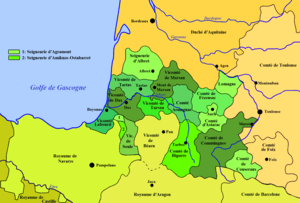
In the 5th and 6th centuries, as a result of the barbarian invasions which swept in successive waves, the city shrank around the castrum, of which a remnant remains in the rear courtyard of the prefecture.
In about 840 AD, the Vikings led a devastating raid following which the Bishop of Bigorre reported that the city Bigorre was beginning with the cathedral, named with originality, la Sède.
At the end of the 12th century, the count of Bigorre settled in his castle of Tarbes, resulting with the court of justice being in his suite. Then, the capital of Bigorre received a Royal Seneschal.
Two noble houses were founded in the 13th century, outside the walls, one the convent of the Cordeliers near Carrère Longue, the other being that of the Carmelites in the vicinity of the Bourg Crabé.
At the end of the medieval centuries, the city was composed of six separate fortified towns, juxtaposed and aligned on an east–west axis, where the original core was ordered around the cathedral. There were thus la Sède, Carrère, Maubourguet and Bourg Vieux flanked to the east of the Count's castle, with Bourg Neuf and Bourg Crabé each surrounded by their own walls.
During the Wars of Religion, in 1569, the troops of Jeanne d'Albret burned the cathedral, the convents and other churches as well as the bishopric. Despite the strategic destruction to try to defend Bourg Vieux, the inhabitants were massacred.
Early Modern era
In the 17th century, after the plague and the problems of housing people of war, Tarbes ensured its revival with the reconstruction of the Episcopal Palace in 1652 (today the office of the prefecture), the foundation of a third hospital in 1690 and two new convents (Capuchins and Ursulines). Irrigation of the land and the water power used by the craftsmen were produced by the system of canals derived from the Adour.
The 18th century announced a growth of the population, and the development of agriculture, crafts and trade. The town expanded and new quarters appeared (such as the current Rue Maréchal-Foch). Then, the Constituent Assembly, which included Bertrand Barère de Vieuzac (Deputy of Bigorre to the Estates-General), decided to undertake administrative reform and Tarbes benefitted by becoming capital of the department of the Hautes-Pyrénées.
19th century
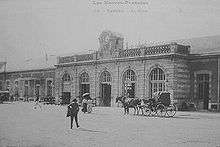


Prerogatives of a chef-lieu
From 1800, Tarbes became the chef-lieu and headquarters of a prefecture (an increase of its administrative role and its functions). In 1806, Napoleon I re-established the National Stud of Tarbes and Tarbes gave birth to the Anglo-Arabian horse breed. In 1859, Tarbes was connected to Paris by rail.
Legacy
In the 19th century, various legacies enrich the public spaces of Tarbes. In 1853, Placide Massey bequeathed to the city the eponymous garden, still unfinished.[6] In 1877, a donation by the former Mayor Antoine Brauhauban was responsible for the construction of an imposing hall which bore his name (this building was destroyed in 1970 to establish outdoor parking).[7] The end of the 19th century still saw the construction of the two fountains of Place Marcadieu, a legacy of the benefactor Félicitée Duvignau.
Industrial development
After the Franco-Prussian War of 1870–1871, General Verchère de Reffye transformed the experimental workshop of Meudon (transferred by train to Tarbes) construction of an artillery workshop (called an arsenal by the people of Tarbes). Thus, Tarbes became an industrial and working-class town but also asserted its military vocation by the construction of the Larrey, Soult and Reffye quarters.
20th century
During World War I, Tarbes intensified its production of artillery by virtue of its geographical position in the back country. Marshal Foch, Commander-in-Chief of all allied armies, was born in Tarbes in 1851.
During World War II, the Resistance was also part of the everyday life of the town of Tarbes, which was awarded the Croix de Guerre.
After the return of peace, the industry diversified and there was an expansion of the population. Tarbes remained a city of strong military character.
21st century
Today, Tarbes has also become a university city and the main activities are now within the tertiary sector (services). In addition to its privileged geographical situation, less than an hour from the Pyrenees mountains, two hours from the Atlantic Ocean and three hours from the Mediterranean via the La Pyrénéenne autoroute, the city offers a certain lifestyle and boasts a cultural life which is packed with clubs and sport.
Economy
Being farther away from Toulouse than other cities of Midi-Pyrénées, Tarbes may appear to display greater economic independence. Also it often occupies the second place in the regional urban hierarchy. It maintains close relations with Aquitaine and, in particular, with Pau, a nearby town of the Pre-Pyrenees.
Industry
.jpg)
Tarbes is the second industrial city of the region. this is particularly illustrated in the field of railway construction and aeronautics with the presence of nearby companies such as Alstom and Daher. Daher-Socata manufactures business and tourism aircraft there, including the TBM 850 and TB 20. Its headquarters and its main industrial site are located on the outskirts of the Tarbes-Lourdes-Pyrénées Airport in the canton of Ossun, south of Grand Tarbes, where its facilities are spread over 53 hectares (130 acres), of which 80,000 square metres (860,000 sq ft) are covered surfaces. At the end of 2006, its strength stood at more than 1,050 people.
Ossun, a neighbouring commune of the agglomeration, is also home to TARMAC, a company dedicated to the dismantling of aircraft for which it was necessary to construct an imposing building. The platform is, again, installed on the Tarbes-Lourdes-Pyrénées airport area, and revolves around the three complementary activities of storage, maintenance and deconstruction. Boostec, based in Bazet, collaborated with EADS-Astrium to build the Herschel space telescope, launched on 14 May 2009.[8]
Zones of activity
In addition to the Aerospace Valley involving DeciElec, Socata/Daher, Pearl and Tarmac, Tarbes is developing several business parks.
- The Park of the Pyrenees, located in Ibos, is equipped to host craft, industrial activities, services and offices.
- The Bastillac University Park is dedicated to technological research. The Park of the Adour, in Semeac, is for industrial, commercial and the tertiary sector.
- Cognac Park, on the road to Pau, is devoted to the craft and the tertiary sector.
- The Ecoparck of Bordères-sur-Echez is the subject of complementary projects regarding energy production (biogas plant project, produced from biomass), the cold-intensive businesses (Pyrenean curing and the planned cooling platform of Dominque Sallaberry Logistics).
University centre
Tarbes also houses the second University centre of the Midi-Pyrénées[9] with a University Institute of technology (IUT) and National School of Engineers of Tarbes (ENIT) having more than 5,000 students.
Tourism
The Tarbes–Lourdes–Pyrénées Airport is still the second of the Midi-Pyrénées.[10] Also in the town centre, the Rex Hotel, a designer hotel addressing a rather affluent clientele, and the arrival of brands such as H&M and new places of leisure (CGR, etc.) seem to attest to the attractiveness of the town.
Agriculture
Often presented as a "market town", Tarbes is home to important halls and market squares, allowing opportunities for local agriculture. Symbol of the local food industry, a Cooperative of tarbais beans including emerged at the heart of the Bastillac zone.
Transport
Air
The small Tarbes-Lourdes-Pyrénées Airport is situated 10 kilometres (6.2 mi) from the town centre. This airport is served by HOP! which provides three daily and two weekend air services to Paris-Orly. Jetairfly, which ensures a connection of two flights a week during the summer.[11] Ryanair serves London Stansted, Dublin, Lisbon and Milan Bergamo, with two and three flights a week, respectively.[11] Meridiana connects to Rome and finally Air Nostrum (Iberia Regional) offers two flights per week to Madrid Barajas. The airport also offers seasonal charter flights to and from the largest European cities.
Rail
The Gare de Tarbes railway station offers direct connections with Paris, Bordeaux, Toulouse, Bayonne and several regional destinations.
Road
Tarbes is also served by the A64 allowing in the direction of Toulouse, to drive freely to Lannemezan or Capvern, and towards Bayonne and joining Pau, which is also accessible from the RD 817.
Politics and administration
Tarbes is the capital of the Hautes-Pyrénées department and concentrates various utilities including the court of grand instance, a branch of the Bank of France, the Chamber of Commerce and local industry, the Chamber of skilled crafts, crafts and Services.
In 2011, the municipality of Tarbes was rewarded with the label "Ville Internet @@@@".
Political trends and results
The municipal history of Tarbes under the Fifth Republic was marked by several waves.
In the elections of 1959, the outgoing Socialist mayor, Marcel Billières, was a victim of the resilience of the Communist Party but especially also the shift to the right, which managed to seize the city hall with the election of Paul Boyrie. He was comfortably re-elected in 1965 (58.4%) and 1971 (55.2%). However, his sudden death a few weeks before the 1977 elections caused confusion in the ranks of the outgoing majority.
In this election, the Communist Paul Chastellain prevailed in the first round (50.6%), at the head of a list of union of the left. He was reelected in 1983 with 54.8% against Jean Journé (UDF-RPR), but took ill with a heart attack during the count. Raymond Erracarret (FCP) was elected mayor by the municipal council. The new councillor regained his chair in 1989 with 54.1% against Jean Journé (UDF-RPR), then with a reduced majority (51.3%) in 1995, against Gérard Trémège (UDF-RPR).
2001 then marked a brand new change: Gérard Trémège, after a merger of the lists of DL-UDF and RPR, became mayor with 50.1% of the vote (26 votes in advance). He was re-elected on 17 March 2008 under the UMP-Radical Party label "Valoisien" this time with 54.3% (1,705 votes ahead of Jean Glavany) and again on 23 March 2014, this time in the first round with 52.95% of the votes.
List of mayors
| Start | End | Name | Party | Other details |
|---|---|---|---|---|
| March 2001 | In progress | Gérard Trémège | UMP | President of the Communauté d'agglomération du Grand Tarbes from 2008 to 2014 Vice-President of the Communauté d'agglomération du Grand Tarbes from 2014 Regional Counsel from 2004 |
| March 1983 | March 2001 | Raymond Erraçarret | PCF | General Counsel |
| March 1977 | March 1983 | Paul Chastellain | PCF | |
| March 1959 | March 1977 | Paul Boyrie | RI | |
| March 1953 | March 1959 | Marcel Billères | SFIO |
Cantons
Since the French canton reorganisation which came into effect in March 2015, the city of Tarbes is subdivided into 3 cantons: .[14]
| Name | Population (2014)[15] | Cantonal Code |
|---|---|---|
| Tarbes-1 | 13,514 | 6510 |
| Tarbes-2 | 13,402 | 6511 |
| Tarbes-3 | 13,984 | 6512 |
Intercommunality
Since January 2017 Tarbes is part of the Communauté d'agglomération Tarbes-Lourdes-Pyrénées. This was created by the merger of the Communauté d'agglomération du Grand Tarbes with 6 neighbouring Communautés de communes. Grand Tarbes had been created in December 1995 from the former Communauté de communes de l'agglomération tarbaise. The Communauté d'agglomération has competences related to transportation, travellers, culture, sports, environment, the university and the city's policy. It now includes 86 municipalities and has some 123,000 inhabitants (2014 legal population, INSEE).
Schools
- Public kindergartens
|
|
|
- Private kindergartens
|
- Public primary schools
|
|
|
- Private primary schools
|
- Public colleges
|
|
- Private colleges
|
- Public secondary schools
|
|
- Private secondary schools
|
Higher academic institutions
- École nationale d'ingénieurs de Tarbes
- National Polytechnic Institute of Toulouse
- Paul Sabatier University
- University of Pau and Pays de l'Adour
- Institut Universitaire de Formation des Maîtres (part of University of Toulouse II – Le Mirail)
- École supérieure d’art des Pyrénées — Pau Tarbes
Health
The city has also a medical centre spread over three sites that make up the Intercommunal Hospital Centre of Tarbes - Vic-en-Bigorre (CHIC-TV). On 6 June 2003, the institution changed its name and became the Hospital Centre of Bigorre (CHB): A short stay site ("La Gespe" in Tarbes) and two geriatric sites ("L'Ayguerote" in Tarbes and Vic en Bigorre); in 2016 the new hospital of Tarbes and Lourdes will be in Lanne, opposite the airport. The Ormeau Polyclinic in collaboration with the Pyrenees-Bigorre Clinic is the second centre of health in Tarbes. Every year in October, are organised the Pyrenean Days of Gynecology, of worldwide recognition.
Demography
In 2012, the commune had 41,664 inhabitants. The evolution of the number of inhabitants is known through the population censuses carried out in the town since 1793. From the 21st century, the communes with more than 10,000 inhabitants have a census take place every year as a result of a sample survey, unlike the other communes which have a real census every five years.[note 1][note 2]
| Historical population | |||||||||||||||||||||||||||||||||||||||||||||||||||||||||||||||||||||||||||||||||||||||||||||||||||||||||||||||||||||
|---|---|---|---|---|---|---|---|---|---|---|---|---|---|---|---|---|---|---|---|---|---|---|---|---|---|---|---|---|---|---|---|---|---|---|---|---|---|---|---|---|---|---|---|---|---|---|---|---|---|---|---|---|---|---|---|---|---|---|---|---|---|---|---|---|---|---|---|---|---|---|---|---|---|---|---|---|---|---|---|---|---|---|---|---|---|---|---|---|---|---|---|---|---|---|---|---|---|---|---|---|---|---|---|---|---|---|---|---|---|---|---|---|---|---|---|---|---|
|
|
|
| ||||||||||||||||||||||||||||||||||||||||||||||||||||||||||||||||||||||||||||||||||||||||||||||||||||||||||||||||||
| From 1962 to 1999: Population without double counting; for the years following: municipal population. Source: Ldh/EHESS/Cassini until 1999[16] then INSEE from 2004[17] | |||||||||||||||||||||||||||||||||||||||||||||||||||||||||||||||||||||||||||||||||||||||||||||||||||||||||||||||||||||
The population of the commune of Tarbes (legal municipal population 2010) established on 1 January 2013, at 43,034 inhabitants, thus placing the commune as fourth of the Midi-Pyrénées region after Toulouse (441,802 inhabitants), Montauban (56,271 inhabitants) and Albi (48,916 inhabitants). In 1995, the Communauté d'agglomération of Grand Tarbes (12 communes, 78,493 inhabitants) was created which, regionally, ranks third behind the Grand Toulouse (37 communes, 705,000 inhabitants), Castres-Mazamet (16 communes, 85,000 inhabitants), Grand Albigeois (17 communes, 82,181 inhabitants) and before Montauban (7 communes of Montauban-Trois rivières, 64,489 inhabitants). The urban centre has 95,029 inhabitants. It includes the more urbanised communes and those nearest to Tarbes, whether or not in the Communauté d'agglomération of Grand Tarbes. We can include the communes of Juillan (4,078 inhabitants), Ossun (2,383 inhabitants), Azereix (1,019 inhabitants, Louey (1,018 inhabitants), Lanne (585 inhabitants), Barbazan-Debat (3,571 inhabitants), Bazet (1 674 inhabitants), Oursbelille (1,243 inhabitants), Momères (676 inhabitants) and Horgues (1,115 inhabitants). In addition, the perimeter of the Grand Tarbes is three times less than that of the urban area which, with 115,857 inhabitants (2009), is the second of the Pyrenees behind Toulouse (1,102,882 inhabitants) and ahead of Albi (92,927 inhabitants) and Montauban (82,193 inhabitants).
| Communes of the Tarbes urban centre | Census date | ||
|---|---|---|---|
| 2011 | Community of communes or agglomeration | Political affiliation of the mayor | |
| Tarbes | 42,888 | CA Grand Tarbes | UMP |
| Aureilhan | 7,941 | CA Grand Tarbes | PS |
| Séméac | 4,669 | CA Grand Tarbes | PS |
| Bordères-sur-l'Échez | 4,338 | CA Grand Tarbes | DVD |
| Juillan | 4,020 | CC Canton d'Ossun | DVD |
| Barbazan-Debat | 3,453 | CA Grand Tarbes | PRG |
| Odos | 3,220 | CA Grand Tarbes | DVG |
| Soues | 3,004 | CA Grand Tarbes | PS |
| Ibos | 2,780 | CA Grand Tarbes | PS |
| Ossun | 2,319 | CC Canton d'Ossun | PS |
| Laloubère | 1,943 | CA Grand Tarbes | UMP |
| Orleix | 1,904 | CA Grand Tarbes | PS |
| Bazet | 1,664 | None | PCF |
| Oursbelille | 1,220 | None | PCF |
| Horgues | 1,093 | CC Gespe Adour Alaric | UMP |
| Azereix | 1,017 | CC Canton d'Ossun | SE |
| Louey | 989 | CC Canton d'Ossun | SE |
| Bours | 783 | CA Grand Tarbes | SE |
| Momères | 665 | CC Gespe Adour Alaric | SE |
| Sarrouilles | 550 | CA Grand Tarbes | PS |
| Salles-Adour | 476 | CA Grand Tarbes | PCF |
| Allier | 383 | CC Gespe Adour Alaric | SE |
| Chis | 299 | CA Grand Tarbes | SE |
Outstanding public buildings and places
Public buildings
The city hall and the courthouse, classical buildings of the 19th century, adjoin the Rue Maréchal-Foch. Built in 1907,[18] it is denoted by its candid monumentality. It is surmounted by a bell tower and faces the Place Jean-Jaurès enthroned with a statue of Danton. On the façade, one can read the motto "Concord, liberty, equality, fraternity, labour." The Hôtel Brauhauban, an 18th-century mansion, is one of its annexes.
Not far away, the Police headquarters occupies two mansions built on the north walls filled in the 18th century to give birth to the current Rue Georges-Clemenceau. The Academy of Inspection of Hautes-Pyrénées occupies a former school, built at the end of the 19th century.
In the La Sède quarter, the prefecture was housed in the old Episcopal Palace, rebuilt in the 17th century. Not far away, lies the old college of Tarbes which became the Lycée Impérial in 1853 and was renamed Lycée Théophile Gautier in 1911. The Council General of Hautes-Pyrénées also has several buildings including the former seminary of priests of the 18th century. The departmental archives are housed in a remarkable building from 1936.
Three places are devoted to the markets: The market hall and the Place Marcadieu, Brauhauban market hall and the Place du Foirail. Near the Brauhauban market hall is an Italian theatre, known as the Théâtre des Nouveautés, which was built in 1885.[19]
Fountains and squares
The city has many fountains. The Place Marcadieu and Place Verdun reproduce the same pattern: They each have two fountains spread at either ends and not in the middle.
Félicitée Duvignau initiated this peculiarity, in Place Marcadieu, by bequest wishing for the building of fountains at each end of this vast esplanade. This relates to an eponymous Baltard-type market hall building in 1883.[20] Inaugurated in 1897,[21] the monumental fountain of the Quatre-Vallées, combining cast iron and sculpture, figures the valleys of Bagnères, Aure, Argelès and the plain of Tarbes.[22] At the other end of the square, the more modest "Source de l'amour" [Source of love], presents an echo of the style.
The Montaut fountain is set at the centre of this public space and was moved close to the square of the same name. Named after its donor, it is carved in stone by Nelli of the Pyrenees and was first erected in 1874.
In 2008, the ensemble was further complemented by the construction of a nearby square planted with palm trees, in the north of its namesake Sainte-Thérèse Church.[23]
The Place de Verdun has fountains of a much more contemporary appearance. To the south, the Grande Fontaine [Great Fountain] forms a playful bell of water. It is assisted in the north by the Droits de l'Enfant [Rights of the Child] fountain, where a water jet raises a ball which can be rotated by only the force of the wrist.
The Alhambra fountain, a replica of the mythical Alhambra fountain in Granada, Spain. The fountain is located at 43 Rue Maréchal-Foch in an open-air shopping area. Around the fountain is a landscaping of greenery.
The Fontaine de l'Inondation [Fountain of the Flood] which was installed in the Place de Verdun in 1901 was relocated, in 1934, to the Place de la Courteboule in the Soult quarter. It features a family and its goat fleeing the waters contained therein. This is an allusion to the flood of 1875.

Other fountains can also be mentioned such as the one of the Cours Reffye, the one in Place Saint-Jean and that of La Gespe in the Place André-Guerlain.

Military heritage
The Haras de Tarbes is composed of an 8 hectares (20 acres) park with Empire-syle buildings including the Maison du Cheval. It was created by Napoleon in 1806 and is the birthplace of a refined breed of horses, the Anglo-Arabian, which are provided to the regiments of hussars. The buildings were built with mostly local materials: Grey marmorifere stone, pebbles of the Adour, bricks and slates. It has a riding school and stables including boxes and with a set of remarkable chestnut panelled ceilings.
During the Franco-Prussian War of 1870, Jean-Baptiste Verchère de Reffye establishes, in the old store of tobacco in Tarbes, an artillery workshop commonly referred to as "Arsenal". It was used for military armament production until 2006. The site is today turning towards the tertiary sector. The old tobacco store houses the Municipal Archives and the Massey Museum reserves. In front stands the House of associations and its bell tower.
The development of the Larrey, Soult and Reffye quarters saw the assertion of the military role of Tarbes in the 19th and 20th centuries. Several barracks were built. With regard to the Larrey barracks (1825), the majesty of the central building, 150 metres (492 feet) long and flanked by two side buildings, is reinforced by the existence of an accessible courtyard from a portal framed by two pavilions of neoclassical inspiration. The ensemble is located in the axis of the Leclerc martial walkways which concentrate memorials including the monumental equestrian statue of Marshal Foch erected in 1935. Firmin Michelet is represented riding Marboré, a horse owned by the Fould family.
The Reffye high school is an old military barracks surrendered by the army after World War II.
Industrial remains
The former site of the Arsenal has been renovated to accommodate shops, places of leisure (cinema, a second bowling facility, laser quest,[24] restaurants, etc.), municipal or community buildings (archives, maison des associations, business, etc.) and companies. The industrial architecture of the place is preserved. Its genesis took place in 1871 with Jean-Baptiste Verchère de Reffye as the main protagonist.[25] Its industrial deterioration occurred following the 2003 announcement of the closure of the GIAT site, heir to the arsenal of 1871.
- Former industrial buildings in Tarbes
- Arsenal building 100 became the Maison des Associations
.jpg) Building 119 became a cinema complex
Building 119 became a cinema complex- Building 103 became the municipal archives
- An overhead crane in building 117, which became a leisure complex
This area is adjacent, in Aureilhan, to the Oustau ceramic factory which was founded in 1873 by Laurence Oustau. The factory buildings, abundantly decorated with glazed bricks, were protected as an Historic Monument in 1994.
- The Oustau ceramic factory in Aureilhan
Religious buildings
Cathedral, churches and mosque

Alongside the former Episcopal Palace which became the prefecture, the Notre-Dame-de-la-Sede Cathedral has a classical façade dating from the 17th century. In contrast, the apse chapel is topped by a lantern tower which was enlarged in the Gothic period and the transept dating from the 12th century are primarily marked by the Romanesque origins of the building. The high altar has a Baroque marble canopy, the implementation of which has been attributed to Dominique Ferrère. One can still see the ceiling painted by Henri Borde and the Testament of Louis XVI carved in the oratory.[26] Saint Vincent de Paul was ordained deacon, here, in 1598.[27]
A little further from the city centre, in the direction of Pau or Ibos, is located the Sainte-Anne Church.
The Saint-Jean-Baptiste Church, commonly known as St. John's Church, is located in the heart of the commercial centre, straddling the pedestrianised Rue Brauhauban, and the Rue Maréchal-Foch. Repeatedly devastated during the Wars of Religion, its structure, dating from the 15th century, remains marked by the Meridional Gothic trend. In the Middle Ages, the building played a major role in the city and the States of Bigorre met there. The church houses a remarkable organ and many Baroque chapels. The high altar is a work of Jean Brunello.[28] The Neo-Romanesque bell tower dates from the 17th century.[29]
Of Languedoc Gothic style, the Sainte-Thérèse Church is opposite the market halls and the Place Marcadieu. Its history began with the establishment of the Carmelites in the 13th century. The bell tower, which is one of the oldest items, dates from the 15th century and is a remnant of the ancient abbey.[30] The church was, however, largely renovated in the 19th century by the architect of the city, Claude Tiffon. It houses a superb organ, beautiful woodwork, some beautiful Baroque statues and paintings of Raymond-Marc Lagarrigue.
The Church of Saint-Antoine was constructed, near the site of the Arsenal, in 1896. It is thus to link to the past workers of this parish who were Conventual Franciscans.[31]
The Church of Saint-Martin, the Sainte-Bernadette Church and the Saint-Vincent-de-Paul Church, which is pyramid-shaped, are of contemporary architecture.
Founded in 1986, the Serbian Orthodox Church of Notre-Dame Source de Vie [Our Lady Source of Life] is decorated with beautiful murals.
In 2005, the first stone of the Omar Ibn al-Khattab Mosque was laid.
- Churches of Tarbes
- The Church of Saint-Anne
- The Church of Sainte-Thérèse
Chapels
The current Théophile Gautier high school, once led by the Doctrinaires (brothers of Christian Doctrine), houses a chapel which has an altar which is classified as an historical monument. It was directed by the Bigorre sculptor Dominique Ferrère during the Baroque period.
The Jeanne d'Arc institution includes a chapel with decor of Art Deco inspiration.
The Ayguerote hospital, which became retirement home, includes a Baroque chapel.
The Carmelite chapel was founded in 1870. Now owned by the town of Tarbes, the chapel became a place of exhibitions. The cloister is not accessible to the public.
The Henri Duparc Conservatory has gradually invested in its adjoining chapel.[32]
Old mansions
The Hôtel de Bricquet (17th century).
In the La Sède quarter the prefecture and the cathedral are visible, the family home of Marshal Foch dating from the 17th century was converted into a museum. It is typically of Bigorre and remains recognisable by its yellow façade. It is possible to visit the room where he was born, and the office of the Marshal, and to observe objects which are related to him.
Other fine examples of Bigorre houses are visible on the Rue de la Victoire, Rue Clémenceau and also Rue Regiment-de-Bigorre. They are recognisable by their carved wooden doors, their coloured plaster frames which enhance grey marmorifere stone, with their wooden roofed balconies and their slate roofs pierced by skylights.
Opposite the Saint-Jean Church, the birthplace of Bertrand Barère is visible.
At the mercy of the movements of his father, Théophile Gautier was also born in Rue Brauhauban. The house is still visible today. The family, however, lived there for only three years. The Rue Brauhauban is also home to the birthplace of another poet of the 19th century, Laurent Tailhade.
English Imperial style or even Neobasque villas dating from the 19th and 20th centuries, adorn the Massey Garden, the Bel Air Park, the Paul Chastellain Park and their respective quarters. The Villa Massey, in the heart of its namesake garden, is Neo-Moorish (19th century). Villa Fould, formerly the residence of Baron Achille Fould, Minister of State of Napoleon III, has been restored. It now houses the headquarters of the Pyrénées National Park. A little further away is Villa Bel Air from the beginning of the 20th century.
Art Nouveau buildings line the Rue Maréchal-Foch and Rue Bertrand Barrère.
Green spaces

Tarbes obtained its fourth flower in 2002 under the Competition of floral cities and villages and seeks to maintain this distinction. Tarbes has also received the Grand Prix national of flowering.[33]
The Massey Garden houses a museum, the cloister of the Abbey of Saint-Sever-de-Rustan, the Higher School of Art of Tarbes, an orangerie, a wildlife park, a bandstand. Depending on the season, it is possible to visit by horse-drawn carriage and small train. It is thus a privileged relaxation area near to the Carmel exhibition hall, the Louis Aragon media library and the Berrens Park tennis courts.[34]
At the centre of the Bel Air Park, sits the old Château Delong better known today as the Villa Bel Air which has become a children's recreation centre. The Sellerie Park, with a more urban aspect, is backed by a separate road.[35]
The Chastellain Park is the haven of greenery of the Villa Fould which contains the administrative headquarters of the Pyrenees National Park.
The Échez Park, a recent green space, is attempting to unite the university quarters of Bastillac and Solazur.[36]
Within the Laubadère quarter, Bois Blancs [White Woods] Park is, similarly, a contemporary creation. It includes five islets symbolizing the five continents plus a central island used to host events. Spaces dedicated to games and sport adorn the area devoted to Europe.[37]
Along the leafy Leclerc paths are gathered various monuments commemorating the two world wars, and which has the equestrian statue of Marshal Foch.
The path of the banks of the Adour, also called Camin Adour, is equipped with a fitness trail and is a popular landscaped walking space enjoyed by the people of Tarbes.
Culture
Museums and exhibition spaces
The Massey Museum is best known for hosting the International Museum of the Hussars. However, it also presents a rich collection of fine arts. The building, located within the Massey Garden, is of Moorish style.
The exhibition room of Carmel is complementary. This place of awareness of art is a former Carmelite convent dating from 1870.
- Museums of Tarbes
- Carmel de Tarbes
- Carmel de Tarbes
- Massey Museum
The Museum of Deportation and Resistance, inaugurated in 1989, was the brainchild of the associations of former deportees and former resistance fighters.
The museum space of the House of the Pyrénées National Park evokes the local flora and fauna.
The French national stud displays old saddles, carriages, a farrier's workshop, etc.
In the birthplace of Marshal Foch, his room has been reconstituted, along with its alcove and his office. It preserves the memories of his personal and military objects, etc.
Musical culture
The city of Tarbes is to the delight of audiophiles, with the last independent record store of the south-west, which moved premises from Pau.[38] Located in the city centre, at 43 Rue Maréchal-Foch, it is reserved for vinyl collectors with numerous musical genres. This place attracts French and foreign travellers as they pass through the Bigorre city.
Theatres
In addition to the exhibition halls, the various stages and theatres of the city, including that of La Gespe devoted to contemporary music. La Pari, the performing arts stage, is still a place for contemporary creativity. The main theatre remains that of the Nouveautés but Le Parvis, a multidisciplinary cultural institution combining music, dance and cinema on the outskirts in the heart of the Le Meridien commercial centre, sees many pieces played within.
A cinema with eleven rooms "all-digital and 3D" opened its doors in 2010 in a former GIAT industrial building, renovated for the occasion.
Events
Throughout the year, Tarbes offers all kinds of activities, here is a comprehensive list:
|
January
|
February
|
March
|
|
April
|
May
|
June
|
|
July
|
August
|
September
|
|
October
|
November
|
December
|
Local media
Newspapers
The group of La Dépêche du Midi has a local daily edition as well as a comparable second edition branded as the La Nouvelle République des Pyrénées (the latter does not appear on Sunday unlike the first which is published every day).
The Sogemedia Group publishes the weekly La semaine des Pyrénées.
A version of the weekly Le Petit Journal is also available in the department.
Radio
FM channels include several local radio stations with their premises in the urban area: Pic FM, Radio País, Atomic, etc.
Other radio stations in the region broadcast local information bulletins such as 100% Radio.
Some national radio stations still have studios in the city such as Fun Radio and NRJ.
Internet
Several web portals of local influence are based in Tarbes, such as Bigorre.org.
There are still several information websites (webzines), sometimes having their own web TV broadcasts such as Tarbesinfo.fr.
Gastronomy
- The Tarbais beans
- Madiran wine
- The black pork of Bigorre
- Gâteau à la broche
- Barèges mutton
Military life
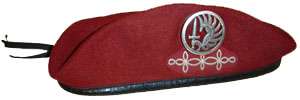
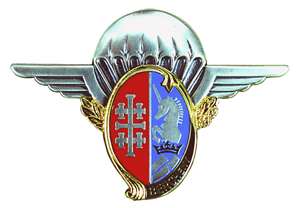
- Military units currently stationed in Tarbes:
- 1st Parachute Hussar Regiment, since 1953.
- 35th Parachute Artillery Regiment, since 1947.
- Military units which have been stationed in Tarbes:
- 53rd Infantry Regiment, 1871-1907
- 14th Field Artillery Regiment, before 1906-1914
- 24th Field Artillery Regiment (France), 1906
- 24th Divisional Artillery Regiment, 1939-1940
- 5th Hussar Regiment, 1838-1839
- 9th Hussar Regiment, 1851-1856
- 1st Parachute Hussar Regiment, 1858
- 2nd Hussar Regiment, 1859-1861
- 10th Hussar Regiment, 1901-1919
- 2nd Hussar Regiment, 1919-1940
- 2nd Hussar Regiment, 1940-1942
- 2nd Hussar Regiment, 1944-1945
- 3rd Company of Mounted Cavalry, before 1906-1914
- 541st Veterinary Group
Sport
Clubs
- Women's basketball: Tarbes Gespe Bigorre, the main sporting team of the town, which participates in the LFB (Ligue féminine de basket 2009-2010) elite and European competitions since 1993 (FIBA EuroLeague Women, FIBA EuroCup Women, and winner of the Ronchetti Cup in 1996)
- Rugby union: Tarbes Pyrenees in Pro D2.
- Football: Tarbes Pyrénées Football, playing in the CFA (4th division)
- Fencing: Amicale tarbaise d'escrime, 11-time champions France with the sabre team (last in 2008).
- Canoe-Kayak: Tarbes Auch Midi-Pyrénées
Events
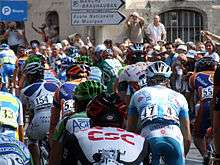
- During the 20th century, Tarbes was on the route of the Tour de France in 1933, 1934, 1951, 1975, 1978, 1987, 1993 and 1995.
- Stage 14 of the 2001 Tour de France departed from Tarbes.
- Stage 11 of the 2006 Tour de France departed from Tarbes.
- Stage 9 of the 2009 Tour de France finished in Tarbes. The stage winner was Pierrick Fédrigo, with Rinaldo Nocentini being the holder of the yellow jersey after the stage finish.
- The 2015 Tour de France is scheduled to have Tarbes as the departure point for Stage 10, heading to the Col de la Pierre St Martin, on 14 July.
- The Tarbes-based Petits As Tournament is a major international tennis competition for 12- to 14-year-old juniors.
Personalities linked to the commune
Political figures

- François de Mazières, born May 22, 1960 in Tarbes, is a senior official and French politician. He was Mayor of Versailles since 2008.
- Bertrand Barère, revolutionary, Deputy of the Third Estate in 1789, member of the Committee of Public safety during the terror, member of the French National Convention
- Gérard Trémège, Mayor of Tarbes since 2001, member of the Radical Party, former President of the Chambers of commerce and industry
- Jean Glavany, Socialist member of Hautes-Pyrénées, President of Grand Tarbes until April 2008, former Secretary of State and Minister of Agriculture
- Charles Antoine de La Roche-Aymon, Bishop of Tarbes
- Maurice Trélut, "moderate" Mayor of Tarbes from 1935 to 1944, prisoner of war, he enlisted in the Resistance and died when deported
- Eugène Ténot, former prefect and member of the Hautes-Pyrénées.
Sportspeople
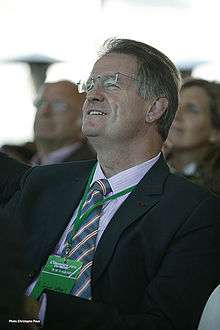
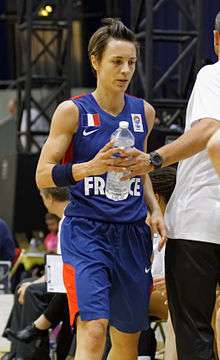
- Dr. Gabriel Sempé, celebrated sportsman, scholar and collector of fine art, death centenary in Tarbes in 1990.
- Louis Destarac, born 1902-?, Rugby union footballer was born here
- Edmond Baraffe born in 1942, former football player for Lille, Red star, international 3 caps
- Bernard Lapasset, born in Tarbes on 20 October 1947, there was president of the Federation French Rugby (1991-2007) then elected President of the IRB 19 October 2007. He had previously held the Chair of the IRB at the time elected and rotating, in 1995-96
- Patrick Baldassara born in 1952, former football player of Olympique Lyonnais, Montpellier and Stado.
- Philippe Dintrans born in 1957, Rugby player for Stadoceste Tarbais, former hooker and captain of the XV of France with 51 caps.
- William Ayache born in 1960, footballer passed by Olympique de Marseille, Paris SG and French international with 21 caps. 3rd the 1986 World Cup
- Jean-Luc Sassus, born in 1962, former professional football player.
- Philippe Bérot born in 1965, former Rugby player three quarter wing SU Agen and Auch. Former coach of Castres, Mont de Marsan and Tarbes. Current assistant coach of the team of Italy.
- Aubin Hueber born in 1967, former Rugby player with Tarbes, RC Toulon and French international with 23 caps
- Christophe Dupouey, born 8 August 1968, mountain biking champion
- Wilfrid Forgues born in 1969, Olympic Champion in Atlanta in 1996, Canoe double Slalom with Frank Adisson, and bronze four years earlier in the Barcelona Olympics. Also five times world champion and 9 times champion of France
- Frank Adisson born in 1969, Olympic Champion in Atlanta in 1996, Canoe double Slalom with Wilfrid Forgues, and bronze four years earlier in the Barcelona Olympics. Also five times world champion and 9 times champion of France
- Olivier Azam, born 21 October 1974, is a former French Rugby Union player
- Sylvain Tanir born in 1975, former Rugby player of RC Narbonne, Section Paloise, Us Dax and Tarbes.
- Sébastien Fauqué born in 1977, Rugby player former opening half of MTG XV, RC Toulon, Aviron Bayonnais and the Atlantic Stade Rochelais
- Xavier Bécas born in 1979, football player, former player of AS Ajaccio, FC Metz, Sedan and Istres
- Julien Laharrague, born 29 July 1978 in Tarbes, Rugby Union player just as his younger brother Nicolas Laharrague who was born in Tarbes in 1981
- Nicolas Lopez, fencer (Sabre fencer) French born 14 November 1980 in Tarbes.
- Anne-Lise Touya, fencer (sabre fencer) French (champion of the World 2001, Nîmes, and 2005 in Leipzig), born 19 October 1981, and his brothers, Damien and Gael, also at the top of the world fencing (Olympic champions of the sabre teams in Athens in 2004)
- Céline Dumerc, born in 1982, basketball player, incumbent captain of the team of France; (European champion in 2009, Olympic runner-up in London in 2012)
- Vincent Forgues born in 1983, third Rugby line player former wing of Toulouse, Pau and Brive.
- Adrien Théaux born in 1984, alpine skier in the downhill and Super G
- Mathieu Crépel born in 1984, French snowboarder
- Lionel Beauxis, born in 1985, champion rugby from the age of 21 in 2006 and international world tricolor 23 caps
- Wenceslas Lauret born in 1987, third Rugby line wing player of Racing Metro and Biarritz Olympique player. French international.
Writers
- Maurice Audebert, philosopher, novelist and dramatist, born at Tarbes in 1921
- Charles Dantzig, writer and editor, Jean Freustié and Roger Nimier Prize in 2003, December prize and Elle in 2006.
- Isidore Ducasse, Comte de Lautréamont, born in Montevideo, Uruguay in 1846 enrolled at Lycée Théophile Gautier, died in 1870
- Henri-Paul Eydoux, writer born in Tarbes (1907-1986)
- Christian Laborde, writer
- Véronique Poivre-d'Arvor French writer born in Tarbes on 23 April 1942
- Laurent Tailhade, writer, polemicist
- Christine de Rivoyre, born in Tarbes on 29 November 1921, is a journalist and French writer
- Théophile Gautier, writer born in Tarbes in 1811 died in 1872
- Jules Laforgue, born in Montevideo, Uruguay in 1860, enrolled at Tarbes and died in 1887.
Military
- Pierre Emmanuel Félix Chazal (1808-1882), Belgian general (naturalised in 1844);
- Ferdinand Foch (1851-1929) Marshal of France (1918), commander-in-chief of Allied forces in World War I including Great Britain and Poland. Academician; a museum was opened at his birthplace in 1951.
- Jean Dembarrère, born in Tarbes 3 July 1747, general of division of Napoleon I, from a noble family
Musicians and singers
- Auguste-Maurice Cocagnac Dominican friar, painter and cartoonist, songwriter, writer and Traveler, born at Tarbes in 1924
- François Deguelt, singer, songwriter was born in Tarbes on 4 December 1932 and died on 22 January 2014
- Robert Kaddouch, concert pianist and international teacher (creator of the k method), Tarbais since 1966
- David Fray, piano virtuoso, born 24 May 1981 in Tarbes.
- Henri Génès, actor and singer
- Yvette Horner, musician, accordionist
- Christophe Lacassagne (born in 1964), baritone from Tarbes
- Victor Mirecki, cellist and music teacher, born 21 July 1847 in Tarbes and died 7 April 1921 in Madrid
- Cécile Ousset, born 1936, pianist
- Gilles Servat, singer and musician, born in Tarbes on 1 February 1945
- The famous trio of the Sangria gratuite group of festive music born in Tarbes in 1998
- Édouard Souberbielle, born in Tarbes in 1899, organist, choirmaster and teacher in Paris, died in 1986.
- Marianne Dissard, born 20 May 1969 in Tarbes, singer, songwriter and French filmmaker.
- DJ Neesty, born in Tarbes in 1960, composer arranger, remixing. He worked for various artists and music labels and two times for the Eurovision Song Contest.
- The Boulevard des airs group was born in the Lycée Marie Curie in Tarbes.
- Jean-Louis Blèze, 1927–2012, French humourist, born in Sarrouilles but who was often in the Tarbes area before going to Paris.
- Vox Bigerri, Tarbes vocal ensemble dedicated to polyphonic singing.
- ENZ, rapper, Parisian of adoption since 2003 was born in Tarbes in the 1980s.
Painters and sculptors
- Henri Borde, painter, died at Tarbes in 1958;
- René Billotte, artist painter, born in 1846 in Tarbes, died in Paris in 1915
- Jacqueline Dauriac, artist, born in 1945 in Tarbes
- Firmin Michelet, sculptor, born in Tarbes in 1875, died in 1951
- Jeane Saliceti, artist, painter, born in 1883 in Tarbes, died in Tarbes in 1959
Filmmakers and actors
- Michel Dieuzaide, born in Tarbes in 1951, photographer and film director
- Christian Gion, filmmaker, born in Tarbes in 1940
- Henri Génès, actor and singer
- Sandra Colombo, comedian
- Marianne Dissard, singer and film-maker
Industrialists, traders and benefactors
- Placide Massey, pharmacist and botanist, great benefactor of the city of Tarbes (1777-1853)
- André Emlinger, military and business leader, originator of the Kennedy Centre (1909-2005)
Others
- Pierre Koffmann, chef
Tarbes in the arts, literature and media
- Jean Paulhan, Les Fleurs de Tarbes ou La Terreur dans les Lettres [The Flowers of Tarbes or Terror in the Letters] (1936, 1941)
- Maurice Utrillo, Tarbes or Winter street scene in Tarbes (1935)
- Unlike the historical D'Artagnan, from Gers, the character of D'Artagnan in The Three Musketeers, by Alexandre Dumas, comes from Tarbes.
- The city of Tarbes is mentioned in the manga The Familiar of Zero, Chapter 28, page 8. It is the city where the hero goes to find a former war machine.
International relations
Tarbes is twinned with:


 Blason of Huesca
Blason of Huesca_COA.svg.png) Blason of Altenkirchen
Blason of Altenkirchen
See also
- Hautes-Pyrénées
- Bigorre
- Communes of the Hautes-Pyrénées department
- List of bishops of Tarbes
- DAHER-SOCATA
- Haras Nationaux
- 1st Parachute Hussar Regiment
- Grand Tarbes, Communauté d'agglomération du Grand Tarbes
Notes
- At the beginning of the 21st century, the terms of census have been amended by Act No. 2002-276 of 27 February 2002, called "grassroots democracy law" on the democracy of proximity and in particular Title V "of census operations", in order, after a power transition period from 2004 to 2008, the annual publication of the legal population of the different French administrative districts. For municipalities with populations greater than 10,000 inhabitants, a sample survey is carried out annually, the entire territory of these municipalities is included at the end of the same period of five years. The first post-legal population from 1999, and fitting in the new system which came into force on 1 January 2009, is the census of 2006.
- In the census table, by Wikipedia convention, the principle was retained for subsequent legal populations since 1999 not to display the census populations in the table corresponding to the year 2006, the first published legal population calculated according to the concepts defined in Decree No. 2003-485 of 5 June 2003, and the years corresponding to an exhaustive census survey for municipalities with less than 10,000 inhabitants, and the years 2006, 2011, 2016, etc. For municipalities with more than 10,000, the latest legal population is published by INSEE for all municipalities.
References
- "Populations légales 2017". INSEE. Retrieved 6 January 2020.
- The Princeton Encyclopedia of Classical Sites:Turba
- "Données climatiques de la station de Tarbes" (in French). Meteo France. Retrieved 8 January 2016.
- "Climat Midi-Pyrénées" (in French). Meteo France. Retrieved 8 January 2016.
- "Normes et records 1961-1990: Tarbes - Ossun - Lourdes (65) - altitude 360m" (in French). Infoclimat. Retrieved 8 January 2016.
- "Tarbes.fr". Archived from the original on 26 November 2006.
- "Site des Marchés de Pays des Hautes-Pyrénées".
- "Des innovations technologiques avec le télescope Herschel: le miroir". Commissariat à l'énergie atomique et aux énergies alternatives. 16 March 2009.
- "Formation Recherche". Grand Tarbes.
- "Une Desserte Privilégiée". Grand Tarbes. Archived from the original on 26 January 2010.
- "Destinations-Vols". Retrieved 16 May 2015.
- "Bus Alezan".
- "Vél'en Ville". Mairie de Tarbes. Archived from the original on 5 March 2016. Retrieved 16 May 2015.
- "Décret n° 2014-242 du 25 février 2014 portant délimitation des cantons dans le département des Hautes-Pyrénées | Legifrance". Retrieved 8 May 2020.
- 2014 legal populations of the Hautes-Pyrénées department
- "Tarbes" [Tarbes] (in French). Retrieved 15 May 2015.
- "65440-Tarbes 2006" [65440-Tarbes 2006] (in French). Retrieved 15 May 2015. and "65440-Tarbes 2012" [65440-Tarbes 2012] (in French). Retrieved 15 May 2015.
- "Office du Tourisme de la Ville de Tarbes". Archived from the original on 31 August 2005.
- "Le théâtre à l'italienne tarbais". mairie de Tarbes. Archived from the original on 5 March 2016. Retrieved 29 May 2019.
- "Patrimoines.midipyrenees.fr". Archived from the original on 12 September 2014. Retrieved 18 May 2015.
- "Les fontaines de la place Marcadieu". Pyrenees-pireneus.com.
- "Tarbes.com". Office du Tourisme de la ville de Tarbes. Archived from the original on 31 August 2005.
- "Tarbes-Info.com".
- "Tarbes. Un bowling et des commerces sur l'ancien site de GIAT - Hautes-Pyrénées". LaDépêche.fr.
- "giat tarbes vivra".
- Article de La Dépêche
- Saint-Vincent-de-Paul, site du Centre Généalogique des Landes
- "Flickr".
- Site de l'Office de Tourisme de la ville de Tarbes Archived 31 August 2005 at the Wayback Machine
- L'église Saint Thérèse : une histoire tourmentée, Pyrenees-pireneus.com
- La communauté des franciscains conventuels, Franciscains-conventuels.fr
- "Tarbes. Le conservatoire Henri-Duparc s'étend à la chapelle". La Dépêche.
- "Tarbes ville fleurie en toutes saisons". Archived from the original on 4 October 2008.
- "Services Espaces Vers de Tarbes". Archived from the original on 26 November 2006.
- "Parc Bel Air". Archived from the original on 10 March 2009.
- "LE PARC DE L'ECHEZ". Archived from the original on 5 May 2009.
- "Grand Tarbes".
- "Pau : le dernier disquaire ferme ses portes" [Pau: The last record store closes its doors] (in French). Retrieved 16 May 2015.